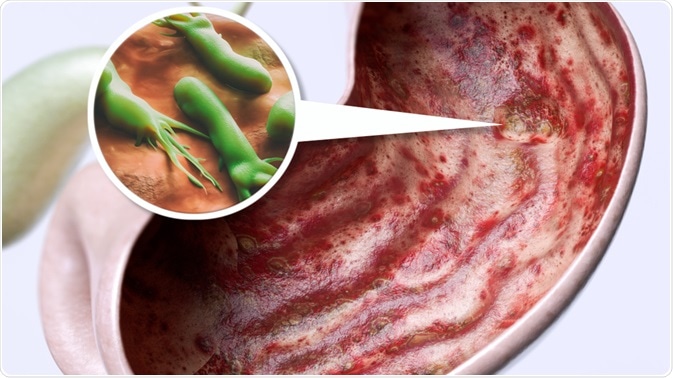Research has shown that the formation of stomach ulcers is associated with colonization of the stomach with Helicobacter pylori bacteria. A significant body of evidence exists demonstrating the link between Helicobacter pylori infection and the establishment of gastrointestinal problems including gastric and duodenal ulcers, gastric carcinoma, and gastric mucosa-associated lymphoid tissue lymphoma.
 Image Credit: Crevis/Shutterstock.com
Image Credit: Crevis/Shutterstock.com
Here, we discuss the link between Helicobacter pylori infection and stomach ulcers, give an outline of the history of the bacteria and the establishment of this relationship, and consider the significance of these findings.
A brief history of Helicobacter pylori bacteria
For over a century, scientists have understood that the human stomach contains a variety of bacteria, and roughly two decades ago the Helicobacter pylori species of spiral bacteria was successfully isolated and cultured by Barry Marshall and Robin Warren. This bacteria is found in the human stomach, and, in self-ingestion experiments, Marshall and Warren were able to show that these bacteria are capable of colonizing the human stomach, resulting in inflammation of the gastric mucosa.
The initial data collected by Marshall and Warren’s experiments encouraged future research into the link between gastric colonization with Helicobacter pylori and a number of upper gastrointestinal disorders, including chronic gastritis, gastric cancer, gastric mucosa-associated lymphoid tissue (MALT) lymphoma, and peptic ulcer disease. For this work on the “discovery of the bacterium Helicobacter pylori and its role in gastritis and peptic ulcer disease”, Robin Warren and Barry Marshall were awarded the 2005 Nobel Prize in Physiology or Medicine.
The growing body of knowledge in this area has had a significant impact on the clinical management of these diseases. Additionally, the discovery of how the persistence of a pathogen within a biological environment also led to new insight into the underlying factors involved in chronic diseases.
The role of Helicobacter pylori infection in the development of stomach ulcers
Evidence shows that when Heliobacter pylori bacteria infiltrates the gastric mucosa of the gastrointestinal tract it causes inflammation. This inflammation is understood to be the root of the link between Heliobacter pylori infection and stomach ulcers. This relationship between Heliobacter pylori and duodenal ulceration is well supported in academic literature and has been found both in infants and adults.
The Heliobacter pylori bacteria species has adapted to thriving in the unfavorable conditions of the gastric mucosal surface. Scientists believe that it has evolved to be able to establish itself in the stomachs of all mammals, meaning that all mammalian species have the potential to develop Heliobacter pylori infections.
To date, all types of Helicobacter species, of which Heliobacter pylori is one, have been shown to be urease positive and have high motility. It is considered that urease facilitates the bacteria’s short-term survival in the acidic environment of the gastric lumen, and the motility allows the bacteria to move rapidly towards the more neutral pH of the gastric mucosa. Here, species of Helicobacter display both urea- and bicarbonate-mediated chemotactic motility toward the mucus layer. Additionally, the spiral morphology and flagellar motility enable the bacteria to break through the viscous mucus layer, allowing the bacteria to establish themselves within more pH-neutral conditions where they can thrive.
Studies have shown that patients with Helicobacter pylori infections have elevated levels of pepsinogen and gastrin alongside reduced levels of somatostatin. Additionally, increases in catalase, lipopolysaccharide, urease, and vacuolating cytotoxin have been found, which are known virulence factors produced by Helicobacter pylori). Data has also uncovered a link between impaired duodenal bicarbonate secretion (associated with Helicobacter pylori infection) and duodenal ulcers.
Increased gastric acid secretion in combination with reduced duodenal bicarbonate secretion results in a lower pH of the duodenum, which leads to the establishment of gastric metaplasia. Infection of this area of the gastrointestinal tract has been seen to induce duodenitis and increase susceptibility to damage caused by exposure to acidic environments, thus, predisposing a person to forming duodenal ulcers. Data has shown that Helicobacter pylori duodenal colonization is significantly linked with the development of duodenal ulcers.
The distribution of Helicobacter pylori infections
Geographical factors seem to impact the prevalence of Helicobacter pylori infections. Data shows that Helicobacter pylori infections are more prevalent in developing countries, where infection rates can be as high as 80%, even in younger people. These rates are significantly higher than those found in industrialized countries, where infection rates remain under 40% and are lower in children and adolescents.
Currently, the exact nature of how Helicobacter pylori infections are acquired is unknown. So far, the bacteria has only been found in humans and some nonhuman primates. On rare occasions, Helicobacter pylori infections have been isolated from pet animals, therefore it is considered that pets may play a risk factor in human Helicobacter pylori infections.
A conclusion on the zoonotic transmission of Helicobacter pylori infection has currently not been established. However, evidence hints that the main route to transmission is via direct human-to-human contact.
References:
- Kusters, J., van Vliet, A. and Kuipers, E., 2006. Pathogenesis of Helicobacter pylori Infection. Clinical Microbiology Reviews, 19(3), pp.449-490. https://www.ncbi.nlm.nih.gov/pmc/articles/PMC1539101/
- Salehi, Z., Mollasalehi, H., Jelodar, M., Kazemi, M. and Zahmatkesh, R., 2009. The Relationship Between <I>Helicobacter pylori</I> Infection and Gastric Adenocarcinoma in Northern Iran. Oncology Research Featuring Preclinical and Clinical Cancer Therapeutics, 18(7), pp.323-328. https://pubmed.ncbi.nlm.nih.gov/20377133/
- What is the relationship between H pylori gastritis and duodenal ulceration? BS Anand, MD. MedScape. Available at: https://www.medscape.com/answers/181753-13848/what-is-the-relationship-between-h-pylori-gastritis-and-duodenal-ulceration
Further Reading